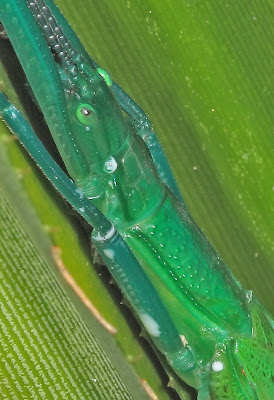Most people are aware that crickets produce sounds. We normally hear the "calling song", that is the sounds produced to attract females. Crickets can produce other sounds announcing territoriality or post-mating sounds. It has been shown that the calling songs are
highly species specific. That is females are “tuned” to answer the calls of
males of their own species. Singing by romantic males of other species just go
“over their heads”!
Females of some mole crickets, family Gryllotalpidae, can produce songs, thereby answering calling males but females of the typical crickets, family Gryllidae, are silent.
Females of some mole crickets, family Gryllotalpidae, can produce songs, thereby answering calling males but females of the typical crickets, family Gryllidae, are silent.
However, there are cricket species where neither sex produce any
sounds at all. How and why this happens in evolutionary terms is often debated.
Some of the ideas advanced include the obvious complexity of sounds in a particular kind of environment—perhaps, one with many cricket species or living in a odd place
where sounds are not needed or desired e. g.—caves, for example where hungry bats may
home in on a singing insect. In such a situation, males would be “selected” by
the predator and this would put the population at risk. Being quiet may have its advantages.
How do silent crickets find one another? Perhaps, they find each other using chemical or visual signals.
How do silent crickets find one another? Perhaps, they find each other using chemical or visual signals.
Here in my rainforest I have discovered some 53 species of
Gryllidae, give or take a few. Of this number some 35% are silent; they produce
no sounds at all. Is this absence of sound production associated with living in
the rainforest environment with the complexity of leaves, trees, shrubs, rocks
etc. Maybe leaves, shrubs etc reverberate and interfere with the calling
song. In such circumstances, maybe chemical signals get the sexes together. The
population numbers of rainforest crickets that don't sing seems higher than one observes elsewhere, so calling by song may not be as important as it is where
populations are dense. Cicada species seem to solve this problem by singing different times of the day and evening and singing during different seasons.
Here is a list of the non-singing species recorded at my site
F=Flightless, LW=long-winged,
capable of flight. A few species have both long-winged and short-winged (flightless)
morphs. Silvinella species live on the forest floor in leaf litter. Both sexes
are wingless. Most of the other are active on leaf surfaces at night. Euscyrtus lives in deep grasses and seems more active during the day.
Aphonoides australis (Walker) LW
A. lowanna Otte
& Alexander LW
A. weeronga
Otte & Alexander or near LW
A. debilis
(Chopard) LW
A. sp nov. 1 LW
A. sp. nov. 2 LW
Genus nr Riatina (stridulatory file?) LW
Euscyrtus hemelytrus (Haan) F, LW
Umbulgaria hillimunga Otte & Alexander LW
Silvinella warraninna Otte & Alexander F
Amusurgus
noorundi Otte & Alexander F
A. hackeri
(Chopard) LW
A.
kanyakis Otte & Alexander LW
A. minmirri
Otte & Alexander LW
A. tinka Otte
& Alexander LW
Metioche
vittaticollis (Stål) F & LW
Trigonidium
bundilla Otte & Alexander F
Trigonidium ?australiana (Chopard) F
T. killawarra
or near Otte & Alexander F
Some
examples.
Gryllidae; Pteronemobiinae; Silvinella wirraninna female
Gryllidae; Trigonidiinae; Amusurgus mubboonis Otte and Alexander male
Gryllidae: Trigonidiinae; Amusurgus tinka female
Gryllidae; Trigonidiinae; Trigonidium bundilla male
Note the absence of a stridulatory file on the right wing on this and the other males below.
Gryllidae; Eneopterinae; Podoscirtini; Aphonoides sp 1 male
Gryllidae; Eneopterinae; Podoscirtini; Aphonoides sp prob australis
Gryllidae; Eneopterinae; Podoscirtini; Aphonoides weeronga male
Gryllidae; Eneopterinae; Podoscirtini; Aphonoides lowanna male light morph
Gryllidae; Eneopterinae; Podoscirtini; Aphonoides weeronga male
Gryllidae; Eneopterinae; Podoscirtini; Aphonoides lowanna male light morph
 |
| Gryllidae; Eneopterinae; Podoscirtini; Aphonoides lowanna male dark morph |
Gryllidae; Eneopterinae; Podoscirtini; Euscyrtus hemelytrus male
Gryllidae; Eneopterinae; Podoscirtini; Euscyrtus hemelytrus female

































